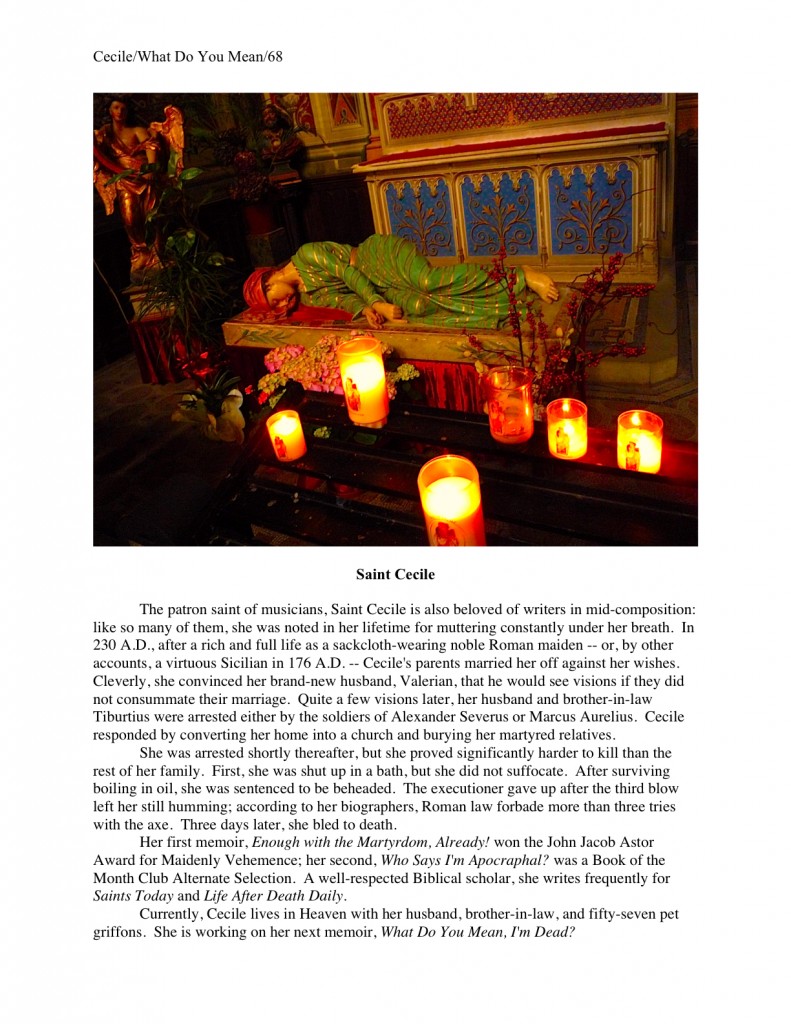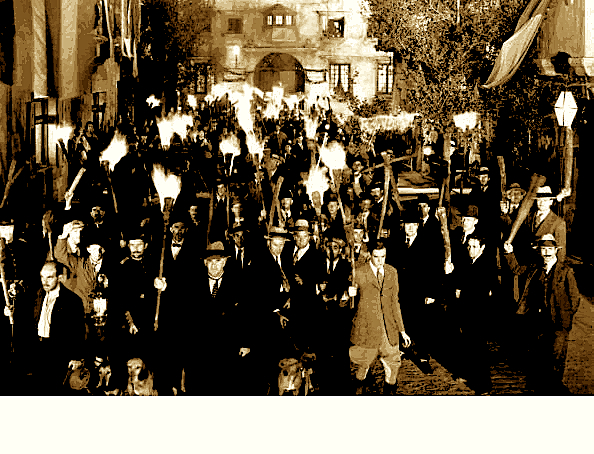
Mortarboard Toss
That ripple of titters you hear out there in the cosmos, dear readers, is the sound of every soul for whom I have ever critiqued a manuscript guffawing: the title of today’s post is something that I have been scrawling in the margins of manuscripts authored by writers living and dead since I first started proofing galleys in my early adolescence. (Long story, but here’s the short version: the thrill of proofing one’s seventeenth published book tends not to be as great as proofing one’s first. Cue one’s favorite writing student.)
For the last week or so, I’ve been talking about various aspects of the gentle art of self-editing, my sneaky way to build up to a number of backlogged readers’ questions about craft. Rather than just jumping into the thick of, say, narrative voice or memoir structure whilst we’re all battened down against the recent wild weather (ice? In MY back yard? For days?), I’ve been nudging you toward starting to read your work like a professional reader. Tricky, eh?
Today’s piece of self-editing advice comes deep from the lair of my most fire-breathing editorial pet peeve: repetition.
Nor am I the only pro whose hackles fly skyward at the site of it; it’s not an uncommon source of annoyance amongst professional readers. As any good line editor can tell you, a tendency to become a trifle miffed in the face of writing that could be better is, while perhaps a handicap in polite society, a positive boon in his line of work.
I was, of course, trained to react to it from my cradle; see earlier comment about junior high school galley-reading. Amongst my kith and kin, developing a strong editorial eye was considered only slightly less important than learning to walk; it was simply assumed that the children would grow up to be writers. My parents would not so much as commit my name to a birth certificate without first figuring out how it would look in print.
It’s true. Ask the nurse who kept trying to get them to fill out the paperwork.
I come by my pet peeves honestly, in other words, but believe me, this one gets some exercise, especially now that computer use is practically universal amongst writers. Especially in recent years.
Why? Well, word and phrase repetition is substantially harder to catch on a computer screen than in hard copy, even on the great big editor’s model currently gracing my desk. I’ve seen 25-pound Thanksgiving turkeys carried to banquet tables on smaller surfaces than my monitor, but even so, I prefer to edit on paper. And even then, I still read the final version out loud, to check for flow and repetition problems.
Again, why? Long-time readers of this blog, chant my perennial answer with me now: NEVER let a submission tumble into a mailbox (or, for e-mailed submissions, an agent or editor’s inbox) until after you have read it in its ENTIRETY, in HARD COPY, and OUT LOUD.
There are manuscript problems that simply cannot be reliably diagnosed any other way. Among them: poor flow, evenness of narrative tone, speeches that a character could not conceivably say within a single breath (a bugbear of many a novelist) — and the kind of percussive repetition that drives those of us who read manuscripts for a living around the bend.
I had a hard lesson in this truth myself a few years ago, after I had spent a couple of months writing a book proposal for a memoir. For those of you who have never had the pleasure of trying to market a nonfiction book, a proposal is as nit-picky a document as they come. Rather than demonstrating that the proposed book is interesting and well-written by, say, handing the finished book to editors, the book proposal limits the actual chapters seen to only one or two — and even those come at the end.
In other words, a professional book proposal does not bear much resemblance to the book being proposed.
So what does it look like? First, it includes a lengthy description of what the book is about, why the author is the best current inhabitant of the earth’s surface to write it, and how it is going to blow every other similar book on the market out of the water. The author is expected to name the volumes to be thus trajected into the air specifically, critiquing them with the full knowledge that the editors who worked on them might well be reading the proposal imminently. Next follows a raft of marketing information, identifying the target readership, naming every mortal organization that might conceivably welcome a speaker on the topic, and so forth. After this exercise in tact, the hapless author is expected to come up with entertaining, well-written synopses of chapters that have not yet seen the light of day.
THEN comes the sample chapter. Basically, the nonfiction writer has to prove, over the course of 50 or so pages of discussion of matters inherently less interesting than the subject matter of the book itself, that she can write.
Piece o’ proverbial cake, right?
Well, no. It is a format in which a typo is both more important and harder to catch — because, let’s face it, the less fascinating a document is, the more the brain wants to skim through it. Lingering lovingly on every word is for when you’re reading for pleasure, not business. As any agency Millicent screening manuscripts all day, every day (except when she’s screening queries) could tell you.
So although I was most definitely interested in the topic of the book I was proposing, it was something of a chore to read, re-read, revise, and screen-proof the proposal. By the time I began printing out the 15 copies for submission my agent had asked me to send, I was relatively certain that the proposal was typo-free. Because I was in a hurry (and so was my agent), I thought, silly me, that I need not invest the time in proofing it in hard copy.
You can see this coming, can’t you?
So there I was, printing up copy 12. (I like to print all the physical copies of my work that my agents will be circulating, rather than printing a single copy and photocopying it, so I can check each page individually. If a photocopier mangles pg. 173, it’s hard to catch.) Out of habit, I read the latest page out of the printer – and realized with horror that for some reason, three lines on page 47 were in 11-point Times New Roman, not 12-point.
If that startling revelation did not make each and every one of you who plans to submit pages to an agent, editor, and/or contest anytime within the next two years clutch your fast-beating hearts and cry, “Oh, no!”, then I can only think it’s getting to be time for me to review standard format for manuscripts again. (If it’s news to you that there is such a thing as a standard for submissions, run, don’t walk, to the mysteriously-named HOW TO FORMAT A MANUSCRIPT category on the archive list at the bottom right-hand portion of this page. You’ll thank me later in your career, I promise.)
Those of you thinking, “Oh, come on — what sensible creature would consider a few words in a slightly smaller font a big deal?” have a point: it’s a difference so subtle that probably only a professional reader would have caught it — and then only in hard copy. After all, neither my agent, my collaborator, or I had noticed in the electronic versions, and I have no idea at what point the switch could have occurred, but that typeface change did subconsciously make those lines seem less important. Since it was a page in the middle of the proposal, though, I realized that fixing it would require reprinting ten pages of every single copy I had already printed.
Oh, please – was there even a second of viable suspense here? Of course, I reprinted it. I could always use the discarded pages for scratch paper, then recycle them. Heck, I could even use them to print up a hard copy draft of the next manuscript I was planning to send to my agent, so I could check for this kind of mistake properly on the next submission.
My point is, no matter how sharp-eyed you are, or how smart — that draft of my proposal had been read on-screen numerous times by two people with Ph.D.s AND an agent, recall — you’re better off proofing in hard copy. A fringe benefit: on paper, it is far more apparent when you’re overusing certain words and phrases.
Which brings me back to my pet peeve. Editors hate repetition for a very practical reason: text that repeats a particular word, phrase, or even sentence structure close together is more tiring for the eye to read than writing that mixes it up more.
Let me give you an illustration, as well as I can on a computer screen. Read through the coming paragraph as quickly as you can:
Without turning in her seat, Mandy suddenly backed the car into the garage. The garage door closed, sealing her and the car inside. The car was warm, cozy, a great place to die. No one would come into the garage for a week, possibly more, and the children never came in here at all. Thinking of the children, Mandy sank back into her seat, the car’s solidity as comforting as a sturdy umbrella in the midst of a sudden downpour. Without thinking, Mandy pushed in the car’s lighter, heating its coils for the benefit of some future cigarette that might never be smoked.
Notice anything about how your eye moved down the lines? If you’re like most quick readers, your eye tried to jump from the first use of Mandy’s name directly to the next; it’s a very efficient way to skim. If you’re a more sensitive reader, the repetition of the garage twice within four words and the car twice within five might have led you to skip the next line entirely.
Apart from encouraging skimming — the last thing you want an agency screener to start doing to your work, right? — word and phrase repetition gives a professional reader the impression that the target market for the book in question is not as well-educated than more diverse set of word choices would indicate. (This is true, incidentally, even if a repeated word is polysyllabic, although to a lesser extent.) The more literary your writing, the more problematic such a perception can be.
What kind of vocabulary is appropriate varies from book category to book category, of course. The average adult novel is aimed at roughly a tenth-grade reading level; literary fiction tends to assume a college-educated reader, and uses vocabulary accordingly. So whenever you see those ubiquitous Mark Twain and Somerset Maugham quotes about never using a complex word when a simple word will do, realize that both wrote for audiences that had not, by and large, shifted the tassel on a mortarboard cap very often.
There is yet another reason to avoid word and phrase repetition whenever possible: it tends to slow down the pace of a scene. Yes, really.
Let’s take another look at poor Mandy’s final moments with all of those redundant words removed and replaced with specific details — note how much snappier her trip to meet her Maker is in this version:
Without turning in her seat, Mandy suddenly backed into the garage. The door closed, sealing her inside. The car was warm, cozy, a great place to die. No one would come to this end of the mansion for a week, possibly more, and the children never ventured in here at all. She sank back into the rich leather upholstery, the Mercedes’ solidity as comforting as a sturdy umbrella in the midst of an unexpected downpour. Without thinking, she pushed in the lighter, heating its coils for the benefit of some future cigarette that might never be smoked.
It’s definitely a smoother read, isn’t it, without all of that eye-distracting repetition? It feels like a quicker read. Added bonus: look how many more character-revealing specifics I was able to incorporate in the space freed up by removing the repeated words — why, Mandy moved up several tax brackets in the second-to-last sentence alone.
Yet if you examine the two versions closely, it’s not the length differential that makes it read quicker. Although the reads more quickly and comfortably, it’s actually not substantially shorter: the original was 103 words, the revised version 97. The action merely seems faster.
Bears some pondering, doesn’t it?
If weeding out repetition in just one paragraph can yield this kind of dramatic result, imagine all of the room you could clear for telling little details if you eliminated similar redundancies throughout an entire manuscript. You might want to print out a copy of your book — perhaps on the back of all that paper I had to discard from my proposal — and try it sometime.
There are, of course, many flavors of redundancy to torment editorial souls. Next time, I shall dive into another very common species that, in its most virulent form, has broken the tension of many an otherwise worthy scene. In the meantime, keep up the good work!



































